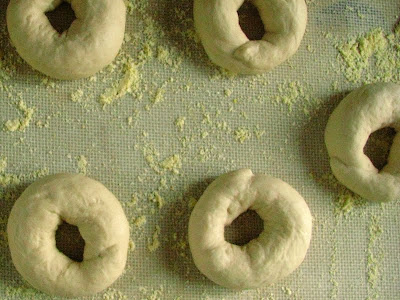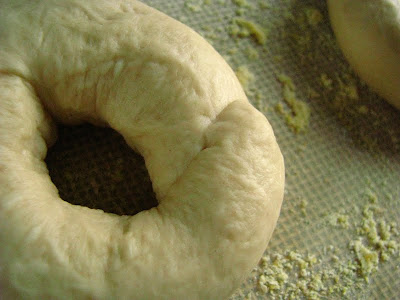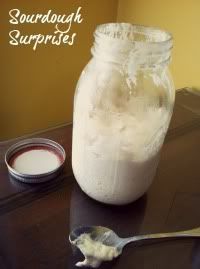Of all the cookbook reading I do, it's possible that I believe the best cookbook writing comes from bread bakers. I know that there is passion in all different genres of the culinary arts, but there is just something about the bakers that click with me. They rise early and alone, they are obsessed with perfection. And, uniting all of them are the common ingredients of flour, water, salt, yeast. When you think of the volumes written about the ratios, techniques, and the utter transcendentalism of this quartet of humble beginning ingredients, it is overwhelming.
I know that sometimes I avoid reading books just because everyone has read and applauded them. I do the same with movies. It's completely feasible that I am the only North American who has never seen (and never will see) Titanic. I think, wrongfully, that I felt this way about Peter Reinhart - the indelible image of the tightly clutched mammoth loaf of bread on the cover of
The Bread Baker's Apprentice
just one of the things on everybody's list and the last thing on my own list of things to read.
When out of town last week, I bought a copy of his 1998 Crust and Crumb from my Mom's co-op in LaCrosse. Peter Reinhart calls this book Master Formulas for Serious Bread Bakers, and said that his methods detail a way to achieve World Class bread. As always, I read the preface, the introduction, the bits of information in the Table of Contents - marveling over all of it masterfully printed on nearly 90 lb paper. When I finally got past the introduction, where a writer typically seems to shed their personal language and really open up into writing as an art form, I found myself re-reading whole pages but for the beauty of sentence structure and the English language as it describes the ancient sustenance that is bread. It's tricky stuff to write both artful and informational simultaneously, and Peter Reinhart does it flawlessly.

"My bread epiphany occurred a few years before the bread revolution hit full force. I was cooking for the seminary of a Christian order in San Francisco (I am still a lay brother in that order, the Christ the Saviour Brotherhood). One of my friends, a very talented cook named Brother Philip Goodrich, took on the then-practically-unheard-of challenge of following all eight pages of Julia Child's instructions, in From Julia's Kitchen, for making French bread. The results were so spectacular that I followed his example, forcing myself to carry out every little step and consulting with him when I stumbled. The bread was so much better than anything we could buy, even the fabled sourdough of San Francisco, that I began making bread every day. Sometimes the results were disastrous, especially when I strayed too far from what I now know to be common bread sense. However, when the bread came out right - even accidentally - when the crust crackled and then dissolved into sweet, roasted wheatiness and the interior felt cool and buttery even without butter, I was hooked. This was my subjective initiation.
 Firm Starter.
Firm Starter.I confess, that while I've read about such (standard) bread techniques as the "windowpane test", I never before did this myself. Perhaps I felt like it was maybe a little needless for a home cook, I also kind of felt like I would be succumbing to full-out craziness, kind of the way I used to toss pizza dough up into the air (but only when no one was looking so they didn't think I was trying to be cool or something). Gluten development that happens through proper mixing is miraculous, and the temperature increases that the dough undergoes also indicate it's readiness. As great as I consider Nancy Silverton's book (Breads from the LaBrea Bakery), I couldn't grasp that until reading it through Peter's eyes.
I have graduated to a WindowPaner. There is no turning back now. To do a window pane test, simple take a small amount of dough, and try and stretch it into a thin pane-like membrane while moving it circularly around. If it rips, the gluten isn't ready, if it stretches thin and lets light pass through, it's ready.

My first duo of loaves was made with what Peter calls a firm starter. It was a starter made with my wild yeast culture that formed the ball seen above. Essentially, starter is mixed with water and bread flour, fermented 4 hours, then left to refrigerate overnight. Being firm, it is able to be kneaded by hand and as it sat it rose and became overwhelmingly sticky. To break it apart into the 6 pieces he suggested, I had to wet my hands thoroughly.
I used my stand mixer to get the sticky dough going, knowing that higher hydration does lead to better, bigger, airier holes in the finished bread. I feel that it is difficult to avoid adding too much flour when working solely by hand, but someday I'll work up to that I hope. It would be nice to have a huge, wooden bench type counter where I could fully let the flour fly, but my reality is an 18 inch maple cutting board that is dedicated to dough. I love to dream.

To calculate when you will bake, work backwards to see about what time you should start. I wanted to bake in the afternoon, so I started the firm starter the morning of the day prior to baking. I think "overnight" usually refers to about 8 hours, but I let it go more like 16 with good result. I also baked these in a pot, Jim Lahey style. The moisture from the bread creates it's own steam, which is trapped in the pot and released as baking goes on and the lid is removed. I was happy with my results.
makes two loaves
for the Firm Starter:
- 1 c. (4.5 oz.) unbleached bread flour
- 6 T. room-temp water
- 1 c. (4 oz.) starter
for the Dough:
- 5 1/4 c. (24 oz.) bread flour
- 2 c. cool water (65-70 deg.)
- Firm Starter, from above use all (11.5 oz.)
- 2 1/2 t. salt
To make the Firm Starter: mix the starter ingredients in a mixing bowl. When they form a ball, turn the dough out onto a floured surface and knead just until all the ingredients are incorporated, and dough forms a smooth ball. Place dough in a clean bowl, cover, and let ferment at room temperature for 4 hours. Then transfer to the fridge overnight.
Remove the Firm Starter from the fridge 1 hour before mixing up the dough. Before mixing, cut it into 6 pieces. It will be pretty sticky, I used wet hands.
To make the dough: combine the flour, water and starter pieces in a stand mixer fitted with a dough hook. Mix on low for 1 minute, then on medium for 3 minutes. (At this point, you can save 12 oz. of the starter to become the Firm Starter or 'chef' for additional loaves at a later time. I assume from reading, that it would be viable in the fridge for up to 3 days.)
Add the salt, and continue mixing for another 4 minutes, or just until gluten sets up. Dough should pass the windowpane test, and read 77-80 degrees on a thermometer. Hand kneading will take 10-12 minutes to get to this stage.
Put the dough in a clean bowl, cover (Peter uses plastic, but I used a lid for my stock pot), and let rise at room temperature about 3 hours. The dough may not double fully, it just needs to "begin swelling".
Divide the dough into 2 pieces, and round each into a ball. Let rise ("use a prepared banneton, basket or mixing bowl and place the smooth side down) about 4 hours until doubled in size. Peter has specific method for this, but I let them rise the way I normally treat breads: one in a well floured linen cloth inside a colander, and the other in a reed banneton (basket) that was heavily coated with flour and wheat germ. He also recommend misting them with cooking spray, and placing them in a plastic bag. I just make sure they are away from drafts, and cover with a dry towel topped by a water-moistened towel. I just have a thing about cooking spray... I'm sure that would work perfectly, though.
About 45 minutes from the end of the second rise, place a cast iron pot (with it's lid on) in a cold oven, and preheat to 475. I decided to bake them both, one after the other, but you could also choose to let a loaf retard in the fridge overnight. Peter notes that it will develop a more sour flavor and that you should remove it from the refrigerator an hour before baking.
Gently turn over the risen loaf, score and transfer the loaf to the hot pot. Replace the lid, and bake for 30 minutes. Remove the lid, and continue baking for 10-15 minutes more until deep golden brown. Remove the loaf to a cooling rack, and cool at least an hour until slicing.
 Blistered Crust.
Blistered Crust.Because I was standing around the kitchen for 1 1/2 hours during baking, and because I had decided to clean and wash out my refrigerator on Sunday afternoon (discovering a pint jar of Sally Fallon crispy peanut butter lurking in the far back), I figured I'd take advantage of the hot oven and make some cookies. Sally Fallon's nut butter tastes a bit different than most nut butter since the nuts are soaked and dehydrated, then blended with coconut oil to replace some of the natural oils that are lost in this process. There is also a little honey in her recipe, which really makes the blonde peanut butter taste unconventional. I liked it, but the Boy-O is both picky and a peanut butter connoisseur. Cookies are sure ways to use up "suspect ingredients", and while he thought they didn't taste like peanut butter, he still gobbled them down.

I cut traditional amounts of butter and sugar in half, since there was oil added to the nut butter I made. The things I loved about these peanut butter cookies were the things that often sadden me about others: they were not too sweet, they were not too rich, and they were both a little chewy and a little crunchy. They also celebrate the homemade nut butter, and I can't tell you how many times I have read "do not use natural-style peanut butter". Use it! And, they will be great.
Natural Peanut Butter Cookies- 1 c. peanut butter (I used Sally Fallon's sprouted kind, but I'd imagine any nut butter would work well)
- 1/2 c. (1 stick) butter, softened
- 1/2 c. brown sugar
- 1/2 c. white sugar
- 2 eggs
- 2 t. vanilla
- 3 c. AP flour
- 1 t. baking powder
- pinch of salt if using non-salted nut butter
Preheat oven to 350.
Sift the flour and baking powder (and salt) in a small bowl.
In a large mixing bowl, cream the nut butter and butter until well mixed. Add both sugars, and mix well. Add about a cup of the sifted, dry ingredients, and blend.
Add eggs, one at a time, and vanilla - mixing well (1 minutes) after each egg addition.
Add the rest of the dry ingredients, and blend until just combined. Form batter into uniform ball.
Arrange them about 2 inches apart on parchment lined baking sheets, and flatten them criss-crossed with the tines of a fork. (They don't spread too much, so you can keep them pretty close together.) Bake for 15-18 minutes, rotating pans about half way through baking time.
Cool on the pan for a few minutes, then transfer to a wire rack to cool completely.


By the time the last of the cookies were cooling, I finally felt I could risk slicing open my first "World Class Bread" loaf. Peter Reinhart's descriptions of a buttery interior, the wheatiness, the thin cracking crust: they were all there. This bread tasted different than the countless others I've made using the exact same ingredients. It was the method and ratio that was changed, and perhaps the romantic way he describes the way that this bread should taste. Because I had formed the loaves the way I did, tiny blisters popped up on the skin of the crust, something that I don't think has happened to my bread before. They were both gorgeous. They were both World Class. They looked luminous inside, and they came from my oven.
It seems I've run into a string of exceptional writers lately, and it causes me to over-analyze my own paltry attempts at words on a page. What I lack in wordiness, I make up for in passion, at least I hope. As for Peter Reinhart... I will be reading The Bread Baker's Apprentice, and I haven't looked forward to anything more in a long time. As I continue to read on through Crust and Crumb, I continue to be infinitely inspired by the lowliest and earthiest food, and the way bakers think. I inch closer to becoming a baker myself. Maybe this is my own "bread epiphany", or maybe just another in a string of epiphanies. All the while, I just sense in the back of my being that one of these days I'll figure out what I want to do, what I want to be when I grow up. Then, certainly, the next obsession will strike.































































